Ukrainian drones hit several military airfields in Russia on Sunday, a source in the SBU told the BBC Ukrainian Service. According to him, as a result of the largest such attack since the Russian invasion, more than 40 aircraft were damaged, including A-50, Tu-95 and Tu-22 M3. The Russian Defense Ministry confirmed the fact of the Ukrainian attack on Russian military airfields, stating that "several units of aviation equipment" caught fire. This is reported by the BBC.
According to the Russian military department, military airfields in five Russian regions – Murmansk, Irkutsk, Ivanovo, Ryazan and Amur regions – were attacked by drones.
The Russian Ministry of Defense called them “a terrorist attack by the Kyiv regime.”
The agency reports that all attacks at military airfields in the Ivanovo, Ryazan and Amur regions were repelled.
Several aircraft caught fire at military airfields in the Irkutsk and Murmansk regions after an attack by FPV drones, the Russian Defense Ministry said, without specifying the exact number of damaged aircraft.
"The fires have been extinguished. There are no casualties among military personnel or civilians," the military department said, adding that some of the attackers have been detained.
SBU on Russian aviation losses
According to the Security Service of Ukraine, as a result of attacks by Ukrainian drones on Russian air bases, 34% of strategic cruise missile carriers were damaged.
"7 billion US dollars. This is the estimated cost of the enemy's strategic aviation, which was destroyed today as a result of the SBU special operation "Web"," the SBU said in a statement on its Telegram channel.
According to some reports, the drones were launched from Russian territory — they flew out of trucks. A source in the SBU writes that the air bases attacked were Olenya (Murmansk Region), Belaya (Irkutsk Region), Ivanovo (Ivanovo Region), and Dyagilevo (Ryazan Region).
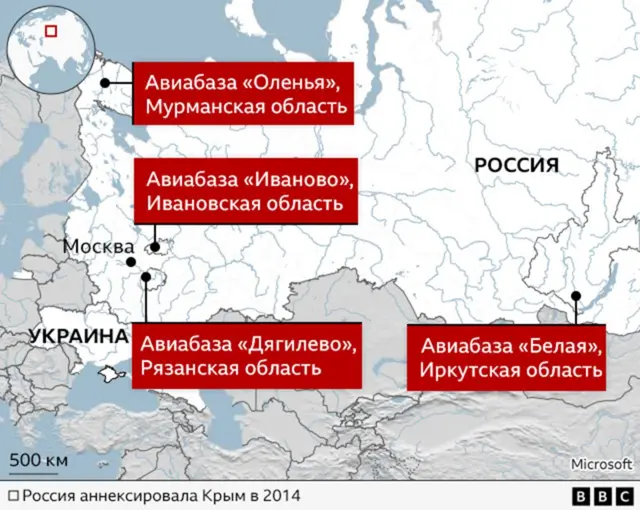
What do the authorities of the attacked regions say?
"The source from which the drones were launched has already been blocked. It was a truck," Irkutsk Region Governor Igor Kobzev wrote on social media, adding that the drone attack was the first in Siberia.
According to Kobzev, the drones attacked a "military unit in the village of Sredniy." This settlement is located near the village of Usolye-Sibirskaya, next to which the Belaya airbase is located.
Murmansk Region Governor Andrei Chibis also confirmed the drone attack on the region's territory.
A video has been published on social media in which a witness to the incident says that drones began flying out of a truck parked near Olenegorsk. The Russian strategic aviation base "Olenya" is located near Olenegorsk.
Russian Telegram channels publish footage showing drones and gunfire. Operation "Web"
A source in the SBU for the BBC Ukrainian Service writes that the special operation was called "Web" and was personally led by the head of the special service, Vasily Malyuk.
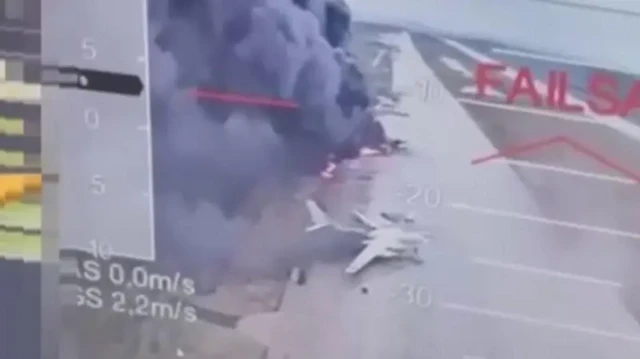
"Right now, the SBU is conducting a large-scale special operation to destroy enemy bombers in the rear of the Russian Federation. SBU drones are working on aircraft that bomb Ukrainian cities every night. Currently, more than 40 aircraft are known to have been hit, including the A-50, Tu-95, and Tu-22 M3," the source said.
One of the videos shown by Ukrainian security services shows a fire over a place described as the Belaya airfield in the Irkutsk region.
Meanwhile, several Russian Telegram channels have published videos showing drones and gunfire. They say it was filmed near the Belaya and Olenya bases.
The news channel Shot also posted a photo of a truck from which Ukrainian drones are likely flying out.
"Drones flying out of a truck were seen not only in the Irkutsk region, but also in the Murmansk region. In both cases, local residents describe the same picture: a heavy-duty vehicle stopped on the highway, and drones flew out of it," the report says.
According to preliminary data, a truck driver has already been detained in the Murmansk region and is giving testimony.
In both cases, we are talking about FPV drones, which presumably had special firmware for remote control.
The Belaya airbase is located in Siberia, almost 4.5 thousand km from the Ukrainian border. The Olenya airfield is located in the Murmansk region, almost 1.7 thousand km from Ukraine.
SBU source: drones flew out of houses hidden in trucks
A source of the BBC Ukrainian Service in the SBU also told how the special service prepared today's drone strike on Russian military airfields.
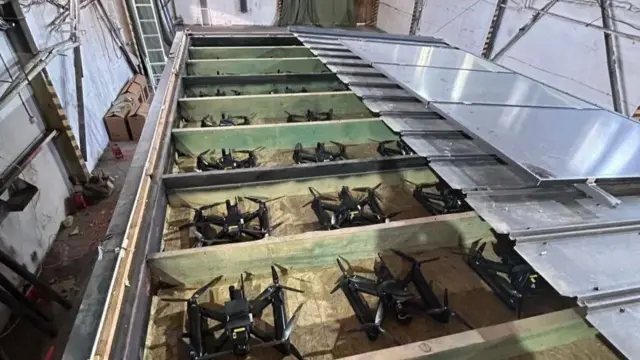
According to the SBU, as a result of the strike on four air bases, 41 Russian strategic aviation aircraft were damaged.
Russian authorities have confirmed that drones have attacked areas where at least two bases are located, but have not commented on the damage caused to the aircraft.
According to an SBU source, today's operation was prepared for more than a year and a half, and its progress was personally controlled by Ukrainian President Volodymyr Zelensky, and was implemented by the head of the Security Service of Ukraine Vasyl Malyuk and special service employees.
A source in the SBU confirmed that Ukrainian drones were flying out of trucks that had driven up to the air bases.
"The SBU first sent FPV drones to Russia, and later mobile wooden houses," the report says. "Later, on Russian territory, the drones were hidden under the roofs of houses that were already placed on trucks. At the right moment, the roofs of the houses were opened remotely, and the drones flew to hit Russian bombers."
At the same time, a source in the SBU claims that “the people who took part in this historic special operation have been in Ukraine for a long time.”
The BBC Ukrainian Service source also provided photographs that allegedly showed drones. The BBC could not verify them.
"This is the Russian Pearl Harbor." What Z-bloggers write
Information about the boxes from which drones flew out to attack airbases is also confirmed by Russian z-bloggers.
"Due to the fact that drones were used from the shortest distance, naturally, it was impossible to remove aircraft from the attack, as well as to use Pantsirs, S-300s, and so on against them," writes the author of the Fighterbomber channel about Russian combat aviation. "I think the attack was unexpected for the PPV squads with "Jedi swords." So the news is unlikely to be good."
According to him, “today will later be called a black day for Russian long-range aviation.”
"I can't even imagine how to respond to this and with what. And yes, we don't have dozens of countries that can give us planes. And what does the Chief of the General Staff think about this?" asks rhetorical questions former adviser to the governor of Kursk region and notable z-author Roman Alekhine. "This is the Russian Pearl Harbor."
"Well, a new stage of confrontation. Actually, it was a matter of time before FPV drones started operating in our deep rear areas," laments Komsomolskaya Pravda war correspondent Alexander Kots. "Now it is important to tell the truth. No matter how bitter it may be."
"The bombers were built during the Soviet Union and are a 'non-renewable strategic resource'," writes the military channel Romanov Light about the losses suffered by the Russian army. "Modern stripes have only thought of covering the fuselages with tires. The idea of stretching a net from fishing line (as is done by operators in the SVO zone) has not occurred to stripes."
"Enemy resources write that two more Tu-160 aircraft could have been hit at the Belaya airbase," TV presenter Ruslan Ostashko carefully estimates the losses. "Together with the Tu-95, that's already at least nine damaged aircraft."
"This is a direct undermining of the nuclear strategic balance of power. This is a reduction in the nuclear security of our country," the authors of the channel "Two Majors" worry.
And the largest pro-war channel, Rybar, notes that the Russian Ministry of Defense has once again proven unprepared to promptly comment on what happened: “Every time chaos occurs, and we are hit ‘where it’s narrow’, and another ‘blunder’ occurs along the lines of the Russian Ministry of Defense, the information agencies act in their usual way: bury their heads in the sand and not react to anything.”
Zelensky: "A brilliant result that will go down in history books"
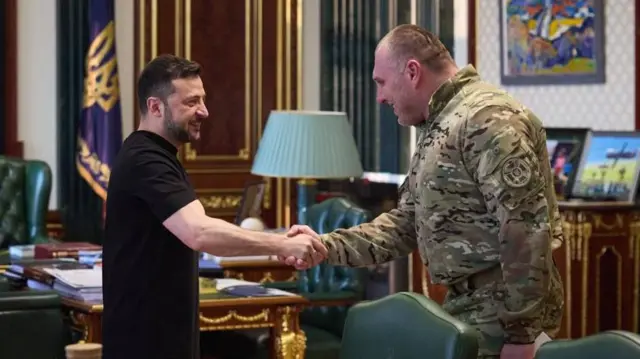
Ukrainian President Volodymyr Zelenskyy gave details of the SBU operation in his evening address.
According to him, she prepared for a year and a half.
“The most interesting thing – and this can already be said publicly – is that the ‘office’ of our operation on Russian territory was located right next to the Russian FSB headquarters in one of their regions,” Zelensky said .
The Ukrainian President said that a total of 117 drones were used in the operation.
"And the corresponding number of drone operators worked. 34 percent of strategic cruise missile carriers at their base airfields were hit," Zelensky said.
“Our people operated in different Russian regions – in three time zones,” the Ukrainian president added.
"An absolutely brilliant result. Of course, we can't tell you everything now, but these Ukrainian actions will definitely be in the history books. Our people who were preparing the operation were withdrawn from Russian territory in time," Zelensky said.
How will the strike on airbases affect the combat capability of Russian troops?
Pavel Aksyonov, military observer for the BBC Russian Service:
A strike on strategic aircraft is one of the most effective possible. These are large targets in the open, they are very vulnerable – any damage to such a bomber almost certainly puts it out of action.
Ukrainian sources, OSINT researchers and Russian pro-war bloggers report the destruction of the Tu-95 and Tu-22M3. The Tu-95MS missile carrier, the latest modification of the bomber, the basic version of which was mass-produced since the 1950s, was mass-produced in the 1980s, when the Tu-22M3 was also built.
That is, these aircraft have not been mass-produced for over 30 years, and many components and parts are not produced for them. Some can be taken from other aircraft. The extent of the damage to the bombers is difficult to determine, but they will probably not be able to fly anytime soon, if at all.
So far, blogs and press reports have been citing the number nine — that's how many planes the Ukrainians allegedly managed to destroy. This is unlikely to have much of an impact on the combat capability of Russia's strategic forces.
The SBU claims that the VKS losses are much greater – 40 aircraft, including the A-50 flying radar, Tu-95 and Tu-22M3. Such losses, if true, can be considered a real catastrophe for long-range and strategic aviation.
But now the protection of targets such as airfields will have to be strengthened. It will be necessary to deploy additional air defense systems, electronic warfare systems, and increase the security staff. Finally, many in the Russian blogosphere are calling for the construction of shelters – much larger and more expensive than shelters for fighters.
The implementation of all this will require the investment of very large funds, as well as the making of great efforts – after all, the blow, as is now clear, can be dealt even in Siberia.
Analysis: Footage of burning Russian bombers is maps of Ukrainian delegation in Istanbul
Svyatoslav Khomenko, BBC correspondent:
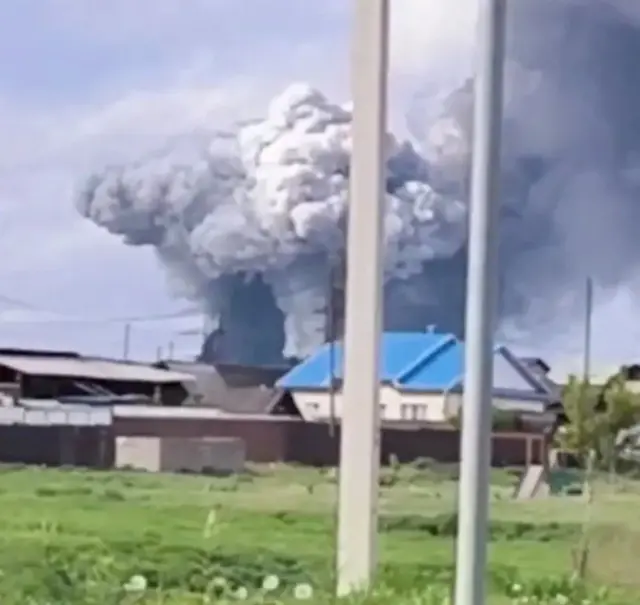
Not long ago, in a conversation with me, one representative of the Ukrainian government complained: supposedly, the main problem of our relations with the Americans is that for some reason they got it into their heads that we have already lost the war. And since they proceed from such premises, they seek the most lenient conditions of capitulation for us, and are terribly offended that we do not appreciate these efforts.
And we, of course, do not appreciate it, because we do not consider that we have suffered a defeat, my interlocutor believes.
I think these are very important words, especially before the second round of Ukrainian-Russian negotiations.
Yes, we do not know what exactly is contained in the memorandum that the Russian side allegedly prepared. But all of Moscow's public rhetoric indicates that it will contain the terms of Kyiv's capitulation.
And the record-breaking drone and missile attacks that have been shaking Ukraine for several nights now are an accompaniment to such a "proposal". You, they say, see that everything is bad. Sign, you have no maps. And you, comrades Americans, press them, you see that everything has already been decided.
The raid by Ukrainian drones on Russian strategic aviation airfields should become clear evidence of what has not been decided.
Photos of burned strategic bombers of the Russian Aerospace Forces are the maps of the Ukrainian delegation.
Therefore, now Kyiv is in some sense interested in holding negotiations with Russia tomorrow – while these maps, that is, photographs, are fresh in memory.
And it seems that it was not for nothing that Volodymyr Zelensky declared that the Ukrainian delegation would nevertheless go to Istanbul and that it would be headed by Defense Minister Umerov, only after these photographs, that is, maps, were shown to the whole world.
































